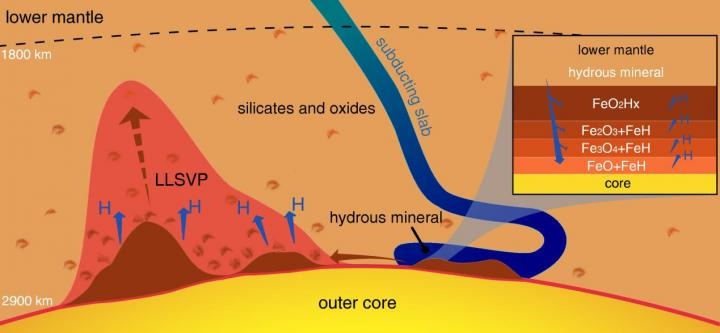Nov 23 2017
A prime topic in the development of clean, abundant energy is splitting water into hydrogen and oxygen. A recent study led by an international research team revealed that when water meets the iron core of the Earth, the extremely high temperatures and pressures existing at the core-mantle boundary can naturally cause water to separate into hydrogen and a super oxidized iron dioxide.
Both the released hydrogen and the retained oxygen in the dioxide have numerous wide-ranging ramifications and outcomes, including the accumulation of oxygen-rich patches, the behaviors of the core-mantle boundary as a huge hydrogen generator, and the separation of the deep Earth's water and hydrogen cycles.
 The Oxygen and Hydrogen Cycling in the Deep Earth. Credit: Science China Press
The Oxygen and Hydrogen Cycling in the Deep Earth. Credit: Science China Press
The article, published in the journal National Science Review, is the result of an international collaboration among the Department of Geosciences, Stanford University, Carnegie Institution for Science in Washington, DC, and the Center for High Pressure Science and Technology Advanced Research (HPSTAR) in China.
The researchers conducted high pressure-temperature experimental studies and theoretical calculations on the reaction between water and iron and examined the reaction products with synchrotron x-ray sources at the Advanced Photon Source, Argonne National Laboratory. They noticed a series of intermediate composition iron oxides and iron hydride, with the final product of hydrogen and the new super oxidized iron dioxide.
The authors insist that based on our knowledge of water in the slabs subducting into the deep interior as a result of plate tectonics movement, 300 million tons of water per year could be carried down and meet iron in the core. This could potentially generate a great amount of free hydrogen at the core-mantle boundary, 2900 kilometers below the surface.
Although such rich hydrogen source is far beyond reach, its upward movements returning to the surface via various paths as free hydrogen, as hydrides through reaction with nitrogen, sulfur and halogens, as carbon hydrides through reactions with carbon, or as water again after recombined with oxygen on the way up, will be crucial issues for understanding geochemistry of deep volatiles.
Moreover, the authors specify that continuous accumulation of super oxidized iron dioxide at the core-mantle boundary throughout the Earth's history may create substantial domains detectable by seismic probes. These domains may stay at the core-mantle boundary indefinitely without disturbance. Nevertheless, they are out-of-place in terms of their very oxidized chemistry in the very reduced environment near the iron core. In the eventuality that they were overheated by the core, an enormous amount of oxygen could be released and exploded to reach the surface, causing cosmic episodes such as the Great Oxidation Event 24 billion years ago that put oxygen into the atmosphere and enabled aerobic life form.
This newly discovered water-splitting reaction at the middle Earth affects geochemistry from the atmosphere to the deep interior. Many previous theories need to be re-examined now.
Ho-kwang Mao, Lead Author